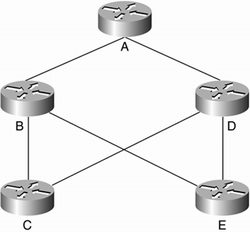RIP Routing Table
Each RIP routing table contains an entry for the Destination IP Address, a specific network host, and a subnet or a default route.
Technical Note: Default RoutesA default route is used when no other route is available to the specified destination. In most cases, the default route points to the Internet Service Provider (ISP) and is configured within the Cisco IOS as follows: Router(config)# ip route 0.0.0.0 0.0.0.0 network_address |
There are five fields in the RIP routing table. Table B-1 gives a brief explanation of each.
Field | Description |
|---|---|
Destination IP Address | This is the destination of any data packet the RIP router receives. The RIP router looks up the destination address of the packet in its routing table to determine where to send the packet. |
Metric | This is the total cost of carrying the packet from origination to destination. This field contains the sum of the costs associated with the network links comprising the end-to-end path across the network. RIP link costs are equal to 1 per link, with a total cost, or metric, of 16 being an unreachable destination. |
Next Hop IP Address | This is the IP address of the next router interface in the network path to the ultimate destination. This field is populated in the router's table if the destination IP address is on a network not otherwise directly connected to the router. |
Route Change | Specified in RFC 1058 this field is not always implemented by router vendors. This field is used to identify changes in routes to specific destination entries. |
Route Timers | There are three timers associated with each route:
|
The following network topology, illustrated in Figure B-1, is used to demonstrate the abbreviated contents of a RIP routing table, focusing on hop count (distance-vector metric):
Figure B-1. Five-node RIP Routed Network

NOTEThe default cost for each hop is 1; however, the network administrator can manually adjust the cost so that links with less bandwidth (such as 56Kbps) could have a cost of 10, giving a weight to those links with more bandwidth (for example, T1). |
Table B-2 reflects the RIP routing table for the network illustrated in Figure B-1.
Router Name | Destination Host | Next Hop | Number of Hops | Via Network Path |
|---|---|---|---|---|
A | Any B Network | B | 1 | Directly Connected |
Any C Network | B | 2 | B-C | |
D | 2 | D-C | ||
D | 4 | D-E-B-C | ||
Any D Network | D | 1 | Directly Connected | |
Any E Network | B | 2 | B-E | |
D | 2 | D-E | ||
B | 4 | B-C-D-E | ||
B | Any A Network | A | 1 | Directly Connected |
C | 3 | C-D-A | ||
E | 3 | E-D-A | ||
B | Any C Network | C | 1 | Directly Connected |
A | 3 | A-D-C | ||
Any D Network | A | 2 | A-D | |
C | 2 | C-D | ||
E | 2 | E-D | ||
Any E Network | E | 1 | Directly Connected | |
A | 3 | A-D-E | ||
C | 3 | C-D-E | ||
C | Any A Network | B | 2 | B-A |
D | 2 | D-A | ||
B | 4 | B-E-D-A | ||
D | 4 | D-E-B-A | ||
Any B Network | B | 1 | Directly Connected | |
D | 3 | D-A-B | ||
Any D Network | D | 1 | Directly Connected | |
B | 3 | B-A-D | ||
Any E Network | B | 2 | B-E | |
D | 2 | D-E | ||
B | 4 | B-A-D-E | ||
D | 4 | D-A-B-E | ||
D | Any A Network | A | 1 | Directly Connected |
C | 3 | C-B-A | ||
E | 3 | E-B-A | ||
Any B Network | A | 2 | A-B | |
C | 2 | C-B | ||
E | 2 | E-B | ||
Any C Network | C | 1 | Directly Connected | |
A | 3 | A-B-C | ||
E | 3 | E-B-C | ||
D | Any E Network | E | 1 | Directly Connected |
A | 3 | A-B-E | ||
C | 3 | C-B-E | ||
E | Any A Network | B | 2 | B-A |
D | 2 | D-A | ||
B | 4 | B-C-D-A | ||
D | 4 | D-C-B-A | ||
Any B Network | B | 1 | Directly Connected | |
D | 3 | D-A-B | ||
D | 3 | D-C-B | ||
Any C Network | B | 2 | B-C | |
D | 2 | D-C | ||
B | 4 | B-A-D-C | ||
D | 4 | D-A-B-C | ||
Any D Network | D | 1 | Directly Connected | |
B | 3 | B-A-D | ||
B | 3 | B-C-D |
EAN: 2147483647
Pages: 269